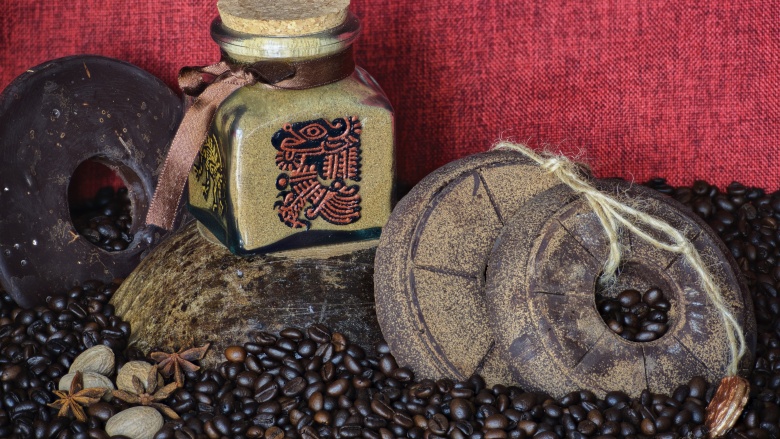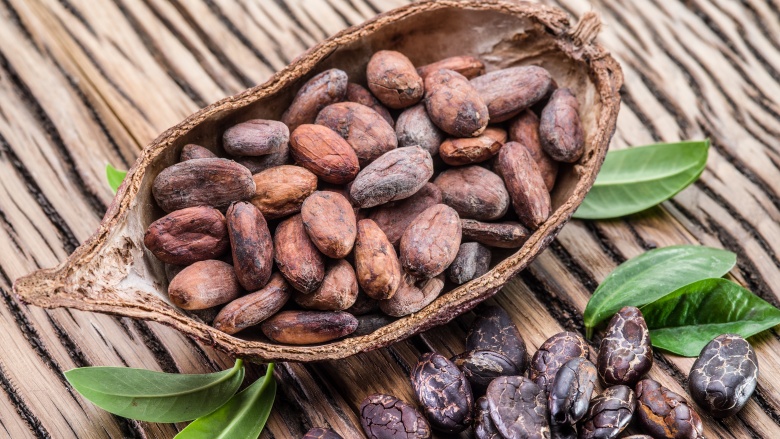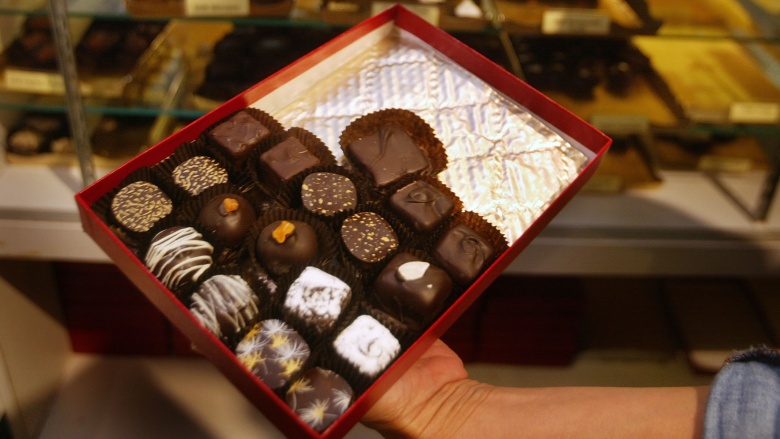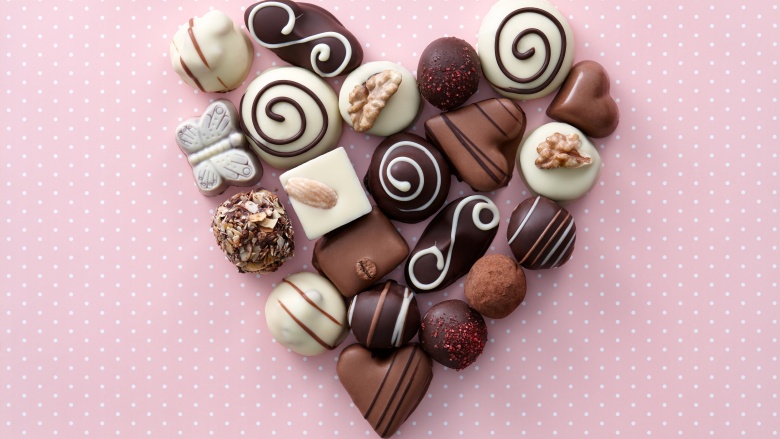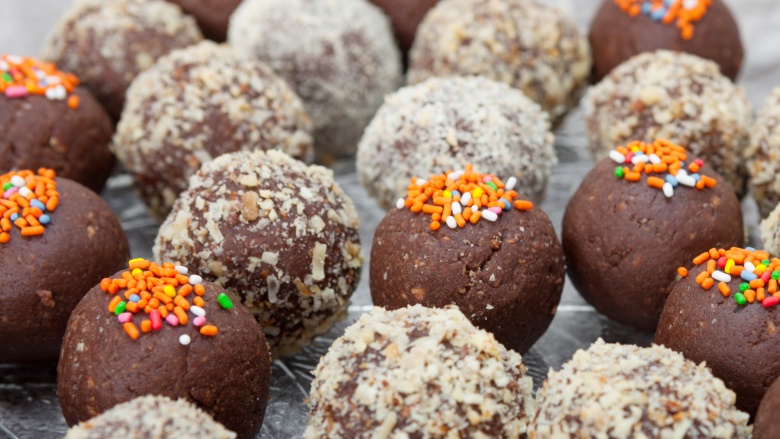The Untold Truth About Chocolate
Will all the chocoholics please stand up? That's a lot of you — Americans reportedly consume an average of 24 pounds of chocolate per person each year, supporting an $18 billion per year industry. You may be surprised to learn, however, that the sweet chocolate candies and desserts you enjoy today weren't always such a sweet treat. With a history spanning over 4,000 years, chocolate has traveled a rocky road to become the mass-produced success it is today.
A brief history of chocolate
Evidence of the use and consumption of chocolate by pre-Olmec Mesoamericans has been found dating back as early as 1900 BC, but it was the Mayans of ancient Mexico who put chocolate on the map. The beans of the cacao tree were believed to have divine or magical properties, and were so valuable they were used as currency. The cacao beans were eventually traded with the nearby Aztecs, who adopted the Mayan way of grinding the cacao beans and invented a bitter drink that was believed to have restorative and aphrodisiac qualities. "Xocolatl," or "the food of the gods," as the drink was called, was reserved for rulers and priests at sacred ceremonies. It is reported that even sacrificial victims may have been given the elixir before they met their grisly fate, which was likely a very small consolation.
In the 1500's, the Spanish conquistador Cortes returned to Europe with the exotic cocoa beans. This, along with the addition of cinnamon and honey, helped create a more palatable version of xocolatl, which was enjoyed by royalty and aristocrats. As the thirst for chocolate grew throughout the European elite, colonial plantations were developed in equatorial regions, often worked by Mesoamerican, or imported African, slaves. Chocolate remained a nectar of the wealthy until 1828, when Dutch chemist Coenraad Johannes van Houten invented the cocoa press, revolutionizing the chocolate industry. Van Houten's invention allowed for mass-produced chocolate that was finally affordable for average folk.
How chocolate is made
The journey from cacao bean to chocolate bar is a long one. The pods of cacao trees, which take up to eight years to mature, are harvested and split open. The beans found inside are sun-dried then removed from their shell, leaving a chocolate "nib." The nibs are then roasted and crushed, producing the raw chocolate material from which all chocolate products are made. Modern versions of Van Houten's cocoa press reduce the fat of the nib by over half, resulting in a cake that can be pulverized into a fine powder.
Swiss chemists Daniel Peter and Henri Nestle (sound familiar?) invented a process that makes the chocolate more blendable, and they incorporated powdered milk, resulting in the method for making liquid chocolate that is still used today. The liquid chocolate is then tempered (heated and cooled repeatedly), which gives the resulting chocolate its luster and texture.
The health benefits of chocolate
Chocolate lovers rejoice! Science confirms that chocolate is indeed good for you ... provided servings remain small-to-moderate in size, and it's the right kind of chocolate. In short, the less processing the chocolate goes through, the more the cocoa bean's natural flavanols are preserved. Flavanols have antioxidant properties, and are proven to lower blood pressure, increase blood flow between the brain and heart, strengthen skin elasticity, and fight inflammation. Higher quality, dark chocolate is your best bet if you are seeking a healthy treat.
Sadly, 2015 reports touting chocolate as a miracle weight loss aid have since been debunked. But the antioxidant thing is still legit, so we can definitely feel good about that.
Is chocolate really an aphrodisiac?
The Aztec ruler Montezuma is said to have downed up to 50 goblets of chocolate a day, to keep up with the demands of his ever-growing harem. But is such a thing even possible, or is the whole "chocolate = aphrodisiac" thing hokum and pipe dreams? Well, chocolate contains a number of chemicals associated with happiness, love, and stamina. When chocolate is consumed, phenylethylamine and serotonin — chemicals which boost mood and energy — are released in the body, which are mildly addicting. Women are more susceptible to these chemicals, which may explain why women are more often "chocoholics." A traditional romantic gift, men often court women with chocolate, as it's been believed to lower her inhibitions.
Scientists continue to debate, however, whether chocolate should actually be classified as an aphrodisiac. According to John Renner, founder of the Consumer Health Information Research Institute (CHIRI), "The mind is the most potent aphrodisiac there is. It's very difficult to evaluate something someone is taking because if you tell them it's an aphrodisiac, the hope of a certain response might actually lead to an additional sexual reaction." Aprodisiac or not, though, it's still delicious, and if deliciousness doesn't win over a lady, we don't know what will.
Making chocolates at home
For those intent on making chocolate from scratch, it is possible to purchase raw cacao beans and embark upon a many-day, roasting, grinding, and tempering process. If that sounds like it'll cramp your weekend plans, a popular chocolate confection amongst home cooks is chocolate truffles. Named for their resemblance to the prized mushroom of the same name, making truffles is surprisingly easy. Chocolate is melted down and blended with corn syrup, cream, and perhaps liqueur. The mixture is then chilled, and scooped into small balls which are then rolled in a variety of coatings, like coconut, cocoa powder, ground nuts, or chopped chocolate. Truffles store well in the fridge or at room temperature, and are a fantastic homemade gift.

